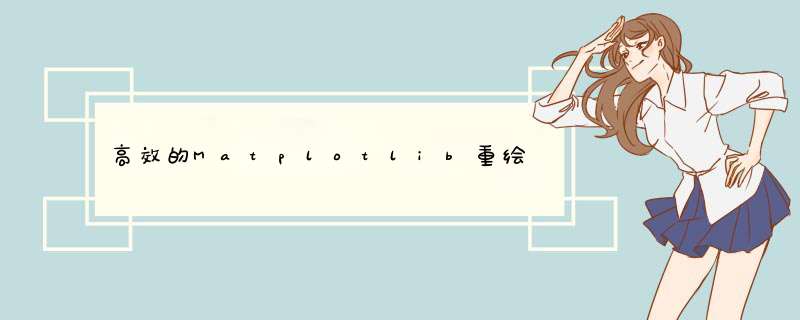
当然!你想要的是发短信。如果您不是在编写gui,则可以使用来简化其中的一些 *** 作
matplotlib.animation,但是如果您希望事物是交互式的,则需要直接处理它。
在matplotlib而言,想要的组合
fig.canvas.copy_from_bbox,然后交替拨打
fig.canvas.restore_region(background),
ax.draw_artist(what_you_want_to_draw)并且
fig.canvas.blit:
background = fig.canvas.copy_from_bbox(ax.bbox)for x, y in user_interactions: fig.canvas.restore_region(background) points.append([x, y]) scatter.set_offsets(points) ax.draw_artist(scatter) fig.canvas.blit(ax.bbox)
简单的划线示例:添加点
就您而言,如果仅添加点,则实际上可以跳过保存和恢复背景。但是,如果走那条路线,由于抗锯齿点会相互重复重绘,因此您会对图进行一些微妙的更改。
无论如何,这是您想要的事物类型的最简单的示例。如上所述,这仅涉及添加点,并且跳过了保存和恢复背景的 *** 作:
import matplotlib.pyplot as pltimport numpy as npdef main(): fig, ax = plt.subplots() ax.pcolormesh(np.random.random((100, 100)), cmap='gray') ClickToDrawPoints(ax).show()class ClickToDrawPoints(object): def __init__(self, ax): self.ax = ax self.fig = ax.figure self.xy = [] self.points = ax.scatter([], [], s=200, color='red', picker=20) self.fig.canvas.mpl_connect('button_press_event', self.on_click) def on_click(self, event): if event.inaxes is None: return self.xy.append([event.xdata, event.ydata]) self.points.set_offsets(self.xy) self.ax.draw_artist(self.points) self.fig.canvas.blit(self.ax.bbox) def show(self): plt.show()main()有时候简单太简单
但是,假设我们要右键单击删除一个点。
在这种情况下,我们需要能够还原背景而不重绘背景。
好的,一切都很好。我们将使用与答案顶部提到的伪代码段相似的内容。
但是,有一个警告:如果调整了图的大小,我们需要更新背景。同样,如果以交互方式缩放/平移轴,则需要更新背景。基本上,您需要在绘制绘图时随时更新背景。
很快您就需要变得相当复杂。
更复杂:添加/拖动/删除点
这是您最终放置到位的“脚手架”类型的一般示例。
由于绘图绘制了两次,因此效率有些低下。(例如,平移会很 慢 )。可以解决这个问题,但是我将这些例子再留一遍。
这实现了添加点,拖动点和删除点。要在交互式缩放/平移后添加/拖动点,请再次单击工具栏上的缩放/平移工具以将其禁用。
这是一个相当复杂的示例,但希望它能使人们理解通常以交互方式绘制/拖动/编辑/删除matplotlib艺术家而无需重绘整个图的框架类型。
import numpy as npimport matplotlib.pyplot as pltclass DrawDragPoints(object): """ Demonstrates a basic example of the "scaffolding" you need to efficiently blit drawable/draggable/deleteable artists on top of a background. """ def __init__(self): self.fig, self.ax = self.setup_axes() self.xy = [] self.tolerance = 10 self._num_clicks = 0 # The artist we'll be modifying... self.points = self.ax.scatter([], [], s=200, color='red', picker=self.tolerance, animated=True) connect = self.fig.canvas.mpl_connect connect('button_press_event', self.on_click) self.draw_cid = connect('draw_event', self.grab_background) def setup_axes(self): """Setup the figure/axes and plot any background artists.""" fig, ax = plt.subplots() # imshow would be _much_ faster in this case, but let's deliberately # use something slow... ax.pcolormesh(np.random.random((1000, 1000)), cmap='gray') ax.set_title('Left click to add/drag a pointnRight-click to delete') return fig, ax def on_click(self, event): """Decide whether to add, delete, or drag a point.""" # If we're using a tool on the toolbar, don't add/draw a point... if self.fig.canvas.toolbar._active is not None: return contains, info = self.points.contains(event) if contains: i = info['ind'][0] if event.button == 1: self.start_drag(i) elif event.button == 3: self.delete_point(i) else: self.add_point(event) def update(self): """Update the artist for any changes to self.xy.""" self.points.set_offsets(self.xy) self.blit() def add_point(self, event): self.xy.append([event.xdata, event.ydata]) self.update() def delete_point(self, i): self.xy.pop(i) self.update() def start_drag(self, i): """Bind mouse motion to updating a particular point.""" self.drag_i = i connect = self.fig.canvas.mpl_connect cid1 = connect('motion_notify_event', self.drag_update) cid2 = connect('button_release_event', self.end_drag) self.drag_cids = [cid1, cid2] def drag_update(self, event): """Update a point that's being moved interactively.""" self.xy[self.drag_i] = [event.xdata, event.ydata] self.update() def end_drag(self, event): """End the binding of mouse motion to a particular point.""" for cid in self.drag_cids: self.fig.canvas.mpl_disconnect(cid) def safe_draw(self): """Temporarily disconnect the draw_event callback to avoid recursion""" canvas = self.fig.canvas canvas.mpl_disconnect(self.draw_cid) canvas.draw() self.draw_cid = canvas.mpl_connect('draw_event', self.grab_background) def grab_background(self, event=None): """ When the figure is resized, hide the points, draw everything, and update the background. """ self.points.set_visible(False) self.safe_draw() # With most backends (e.g. TkAgg), we could grab (and refresh, in # self.blit) self.ax.bbox instead of self.fig.bbox, but Qt4Agg, and # some others, requires us to update the _full_ canvas, instead. self.background = self.fig.canvas.copy_from_bbox(self.fig.bbox) self.points.set_visible(True) self.blit() def blit(self): """ Efficiently update the figure, without needing to redraw the "background" artists. """ self.fig.canvas.restore_region(self.background) self.ax.draw_artist(self.points) self.fig.canvas.blit(self.fig.bbox) def show(self): plt.show()DrawDragPoints().show()欢迎分享,转载请注明来源:内存溢出

 微信扫一扫
微信扫一扫
 支付宝扫一扫
支付宝扫一扫
评论列表(0条)